3-ISOBUTYL-1-METHYLXANTHINE
Synonym(s):1-Methyl-3-isobutylxanthine;3,7-Dihydro-1-methyl-3-(2-methylpropyl)-1H-purine-2,6-dione;3-Isobutyl-1-methyl-2,6(1H,3H)-purinedione;3-Isobutyl-1-methylxanthine - CAS 28822-58-4 - Calbiochem;IBMX
- CAS NO.:28822-58-4
- Empirical Formula: C10H14N4O2
- Molecular Weight: 222.24
- MDL number: MFCD00005584
- EINECS: 249-259-3
- SAFETY DATA SHEET (SDS)
- Update Date: 2025-12-27 15:38:00
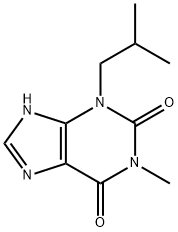
What is 3-ISOBUTYL-1-METHYLXANTHINE?
Description
IBMX (28822-58-4) is a pan-specific inhibitor of phosphodiesterases (IC50=2-50 μM). Inhibition of PDEs leads to increased concentration of intracellular cAMP which activates PKA.2?IBMX does not inhibit PDE8 or PDE9.3?Weak adenosine receptor antagonist.4
Chemical properties
White Needles with Yellow Cast
The Uses of 3-ISOBUTYL-1-METHYLXANTHINE
3-Isobutyl-1-methylxanthine is used in inhibition of phenylephrine-induced release of 5-hydroxytryptamine from neuroendocrine epithelial cells of the airway mucosa (IC50 = 1.3 uM). Also inhibits ion channels in the neuromuscular junction, GH3 cells, and vascular smooth muscle cells. Inhibits the growth of carcinoma cells both in vivo and in vitro in mice.
The Uses of 3-ISOBUTYL-1-METHYLXANTHINE
A nonspecific inhibitor of phosphodiesterases
The Uses of 3-ISOBUTYL-1-METHYLXANTHINE
phosphodiesterase inhibitor
What are the applications of Application
IBMX is a potent and nonspecific inhibitor of PDE (phosphodiesterases) and can increase intracellular cyclic AMP levels
Definition
ChEBI: 3-isobutyl-1-methyl-9H-xanthine is a 3-isobutyl-1-methylxanthine. It is functionally related to a 9H-xanthine. It is a tautomer of a 3-isobutyl-1-methyl-7H-xanthine.
General Description
3-isobutyl-1-methylxanthine/IBMX is a non-selective, non-specific inhibitor of cAMP and cGMP phosphodiesterases. IBMX can induce melanogenesis, and can be used as a positive control in melanogenesis research. In oocyte research, IBMX assists in maintaining the germinal vesicle (GV) arrest of prophase I oocytes.
Biological Activity
Phosphodiesterase inhibitor (IC 50 values are 13, 18, 19, 32 and 50 μ M for PDE4, PDE3, PDE1, PDE5 and PDE2 respectively). Suppresses α -adrenoceptor-mediated 5-HT release from neuroendocrine epithelial cells (IC 50 = 1.3 μ M).
Biochem/physiol Actions
The increase in cAMP level as a result of phosphodiesterase inhibition by IBMX activates PKA, leading to decreased proliferation, increased differentiation, and induction of apoptosis. IBMX inhibits phenylephrine-induced release of 5-hydroxytryptamine from neuroendocrine epithelial cells of the airway mucosa (IC50: 1.3 μM). IBMX also serves as an adenosine receptor antagonist. IBMX has been shown to inhibit ion channels in the neuromuscular junction, GH3 cells, and vascular smooth muscle cells. IBMX induces calcium release from intracellular stores in sensory neurons.
Storage
+4°C
Purification Methods
Recrystallise it from aqueous EtOH. [Beilstein 26
References
1) Beavo et al. (1970), Effects of xanthine derivatives on lipolysis and on adenosine 3′,5′-monophosphate phosphodiesterase activity; Mol. Pharmacol., 6 597 2) Tomes et al. (1993), Isobutylmethylxanthine and other classical cyclic nucleotide phosphodiesterase inhibitors affect cAMP-dependent protein kinase activity; Cell Signal., 5 615 3) Soderling et al. (2000), Regulation of cAMP and cGMP signaling: new phosphodiesterases and new functions; Curr. Opin. Cell Biol., 12 174 4) Daly et al. (1987), Adenosine receptors: development of selective agonists and antagonists; Prog. Clin. Biol. Res., 230 41
Properties of 3-ISOBUTYL-1-METHYLXANTHINE
| Melting point: | 200-201 °C(lit.) |
| Boiling point: | 363.42°C (rough estimate) |
| Density | 1.2042 (rough estimate) |
| refractive index | 1.6500 (estimate) |
| storage temp. | -20°C |
| solubility | DMSO: 1 M with gentle warming |
| form | powder |
| pka | 8.61±0.70(Predicted) |
| color | off-white |
| BRN | 247859 |
| Stability: | Stable for 2 years from date of purchase as supplied. Solutions in DMSO or ethanol may be stored at -20°C for up to 3 months. |
| CAS DataBase Reference | 28822-58-4(CAS DataBase Reference) |
Safety information for 3-ISOBUTYL-1-METHYLXANTHINE
| Signal word | Warning |
| Pictogram(s) |
 Exclamation Mark Irritant GHS07 |
| GHS Hazard Statements |
H302:Acute toxicity,oral |
| Precautionary Statement Codes |
P264:Wash hands thoroughly after handling. P264:Wash skin thouroughly after handling. P270:Do not eat, drink or smoke when using this product. P330:Rinse mouth. |
Computed Descriptors for 3-ISOBUTYL-1-METHYLXANTHINE
| InChIKey | APIXJSLKIYYUKG-UHFFFAOYSA-N |
New Products
4,4-Difluoropiperidine hydrochloride tert-butyl 9-methoxy-3-azaspiro[5.5]undecane-3-carboxylate Indole Methyl Resin N-Isopropylurea N,N-Dicyclohexylcarbodiimide(DCC) MELDRUMS ACID 5-METHYLISOXAZOLE-4-CARBOXYLIC ACID Magnessium Bis glycinate Zinc ascorbate 1-bromo-2-butyne 2-acetamidophenol 9(10H)-anthracenone Erythrosin B, 4-Piperidinopiperidine 2-((4-morpholinophenylamino) (methylthio) methylene) malononitrile 2,4-dihydroxybenzaldehyde 3-(4-morpholinophenylamino)-5-amino-1H-pyrazole-4-carbonitrile Methyl 2-methylquinoline-6-carboxylate 2,6-dichloro-4-nitropyridine 4-Bromo-2-chlorobenzonitrile 2-(benzylamino)acetic acid hydrochloride 4-(tert-Butoxycarbonylamino)but- 2-ynoic acid 3,4-dihydro-2H-benzo[b][1,4]dioxepine 1-Phenyl-1-cycloprppanecarboxylicacidRelated products of tetrahydrofuran
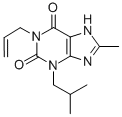


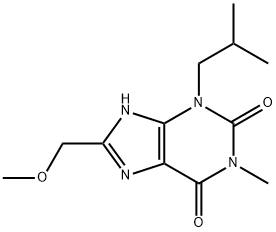
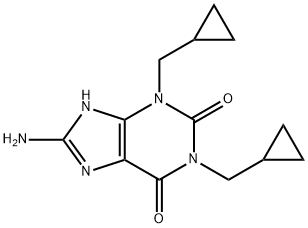
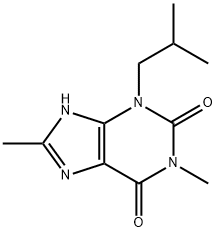
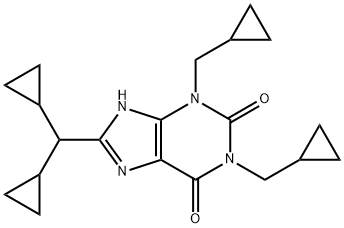
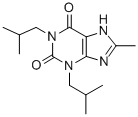
You may like
-
 28822-58-4 3-Isobutyl-1-methylxanthine 98%View Details
28822-58-4 3-Isobutyl-1-methylxanthine 98%View Details
28822-58-4 -
 3-Isobutyl-1-methylxanthine, 99%+ CAS 28822-58-4View Details
3-Isobutyl-1-methylxanthine, 99%+ CAS 28822-58-4View Details
28822-58-4 -
 3-Isobutyl-1-methylxanthine CAS 28822-58-4View Details
3-Isobutyl-1-methylxanthine CAS 28822-58-4View Details
28822-58-4 -
 3-Isobutyl-1-methylxanthine CAS 28822-58-4View Details
3-Isobutyl-1-methylxanthine CAS 28822-58-4View Details
28822-58-4 -
 3-Isobutyl-1-methylxanthine CAS 28822-58-4View Details
3-Isobutyl-1-methylxanthine CAS 28822-58-4View Details
28822-58-4 -
 20677-73-0 (2,2-diethoxyethyl)methylamine 98%View Details
20677-73-0 (2,2-diethoxyethyl)methylamine 98%View Details
20677-73-0 -
 3-(4-(hydroxyamino)-1-oxoisoindolin-2-yl)piperidine-2,6-dione 98%View Details
3-(4-(hydroxyamino)-1-oxoisoindolin-2-yl)piperidine-2,6-dione 98%View Details -
 57381-49-4 2-bromo-4-chlorobenzonitrile 98%View Details
57381-49-4 2-bromo-4-chlorobenzonitrile 98%View Details
57381-49-4
